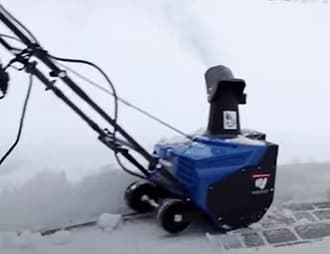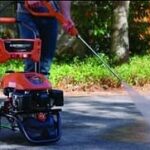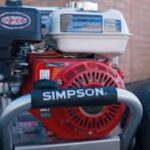As an Amazon Associate, this site earns commissions from qualifying purchases. For more information click here.
It can be alarming to hear a snow blower engine surge, but most of the time, you can skip the repair shop. This is an engine problem you can fix on your own. Here you will discover the reasons why this happens, the solution and how to prevent it from taking place again.
When a snow blower is surging, it is usually due to a clogged carburetor jet. Other possible causes are broken carburetor springs, a worn out gasket or a dirty air filter.
Carburetor is Blocked
Small engine surges can usually be traced to the carburetor. There are two likely causes: old fuel residue or the engine is running too lean. Let’s look at each one and how to fix it.
Old fuel. If you let gas sit in the tank for a month or longer, it becomes a gooey substance. It is unusable and might prevent the engine from running.
The quickest solution is to drain the tank, clean the residue and pour fresh fuel.
If you don’t need to use your snow blower right away, you can put Seafoam in the tank after draining and cleaning. Let it sit for 6-8 hours before adding fresh fuel.
Running lean. If a snow blower does not receive enough gas, it won’t run correctly. The carburetor mixes air and fuel and there has to be a specific amount of both for the engine to work. Too little gas and the fuel mix becomes too lean.
If surging occurs when the snow blower moves, the problem is with the main gas circuit. If surging happens when the blower is idle, the idle jet requires cleaning.
- Check your owner’s manual to find the idle jet.
- Take the jet out. Use a brush and Gumout carburetor cleaner to remove the grime.
- Put the jet back on and try the snow blower.
Some snow blower carburetors let you adjust the idle jet. If cleaning does not work, adjust the adjustment screw and make the mixture richer. Make a small adjustment and see how the engine responds.
You will need a screwdriver to turn the adjuster. Make only a very small adjustments and see how the engine reacts. Small, incremental adjustments can make significant changes to the fuel mix, so be careful.
If your snow blower hasn’t been used for months and refuses to start, press the primer bulb a few times. This sends fuel into the carburetor, speeding the ignition process.
Worn Out Gasket
The gasket keeps air from reaching the engine. Snow blowers need a mixture of fuel and air, but too much causes the engine to run lean and surge. The gasket works as a sealant and ensures only the right amount of air goes into the system.
Worn out gaskets need to be replaced. In most snow blowers you have to remove the carburetor to access the gasket. Carburetors are usually under the air filter so you have to remove the filter and its cover first.
After taking off the cover and carburetor, disconnect the fuel line. Remove the worn out gasket and install a new one. Put fuel line, carburetor and covers back on. Turn on the snow blower and observe how the engine works.
Related. Why Your Snow Blower is Pushing Snow
Check the Air Filter
A dirty air filter can affect engine performance of any small engine, including snow blowers. An air filter keeps dirty particles from getting into the engine.
Since an air filter serves as a screen, it accumulates dirt. This causes two problems: the dirt clogs the filter and prevents air from getting in. Second, the dirt buildup will make its way into the engine. The air filter ends up producing the debris it is supposed to keep out.
Air filters should be replaced at least every few months. Cleaning regularly is recommended but at some point it has to be replaced.
Snow blower air filter locations vary so look it up in your manual. Lift the cover up, remove the filter and install the new one.
Broken Springs
Carburetors have springs which allow the valves to close and open when needed. The springs get worn out through constant use, and this can affect the engine.
The first thing you should do is check the spring. Its installation varies so look in your operating manual for its location.
Examine the spring. You have to replace the spring immediately if there is damage. If there are no missing parts, check if it is correctly installed. Handle the springs carefully to avoid damage.
Use pliers to remove the broken spring and install the new one. Follow the instructions on your new spring for its installation.

How to Prevent Snow Blower Engine Surge
After fixing an engine surge issue, the next step is prevention. There are a lot of things you can do but the following are the most important.
Regular maintenance. Clean your snow blower after each use. Wipe the snow and other debris off the augur, chute, tires and the rest of the machine. Keeping your snow blower clean goes far in prolonging its lifespan.
If the snow blower keeps surging, put fuel stabilizer in the tank and let the engine run. Doing this allows the additive to clear out the residue. You can also pour carburetor cleaning solutions to speed the process.
Replace worn out parts. Gaskets, spark plugs, air filters and other components wear out. Replace them immediately with new, compatible components. Running a snow blower with old spark plugs, filters etc. puts extra stress on the engine and will wear the rest of the system out.
It’s a good idea to buy reserves for the most vulnerable ones like the spark plug, air filter, gasket etc. So if the snow blower suddenly surges, you can install a new part quickly.
The following parts are the most likely to get worn out. You don’t need to have a reserve of each (though that is ideal), but it helps to know what you might require.
- Air filter
- Fuel filter
- Spark plug
- Ignition coil
- Control cable
- Fuel line
- Primer bulb
- Shear pin and bolt
- V-belt
- Drive disk
Replacement parts are available from the manufacturer website, various online stores and physical stores. Do make certain you have the right part number.
Monitor the fuel mixture. A lean fuel mix increases the chances of an engine surge. To avoid this, pour the exact fuel amount recommended by the manufacturer. Second, make sure the air filter is clean. Third, inspect the tank and cap regularly for any holes or leaks.
Do not leave the choke on all the time. You should only do this if the blower needs a cold start. Turn the choke off when the engine starts. If you always have the choke on, it can lead to an engine surge. The blower will also consume more fuel.
Tips to Keep Snow Blower Carburetors Clean
Most engine surge problems are caused by a clogged carburetor. A clean carburetor not only reduces the possibility of an engine surge, but other problems as well. Here are some suggestions.
Clean the choke and the carburetor bore, also known as the throat or barrel. These parts are often clogged by gummed fuel, so regular maintenance is a must.
Cleaning carburetors is straightforward, but in other cases you might have to disassemble it. Do this in a well-lit, clutter-free place. Take out one piece at a time and note which part came before, as you need to put it back the reverse order you took them out.
A lot of debris and gunk end up in the jets and fuel bowls. If the RPMs are moving up and down, the bowls, jets or both are clogged. A quick spray from any good carburetor cleaner should fix this. Clean both before too much residue builds up. If you don’t have a carburetor spray, an air compressor could work.

I love the outdoors and all the tools for maintaining gardens, yards and lawns. The only thing I am more passionate about is sharing what I know about garden and outdoor equipment.


